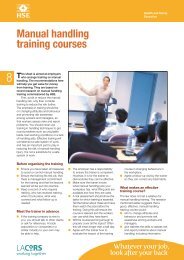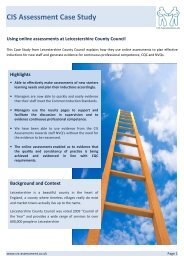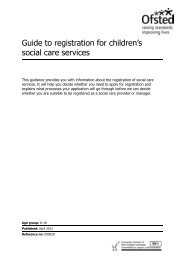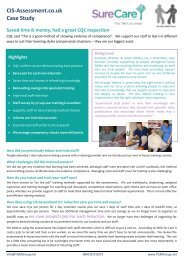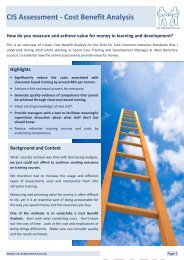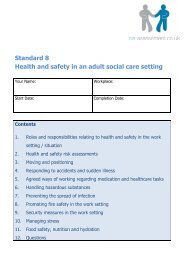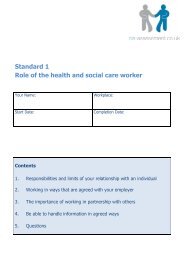Basic advice on first aid at work
Basic advice on first aid at work INDG347(rev1)
Basic advice on first aid at work INDG347(rev1)
- No tags were found...
Create successful ePaper yourself
Turn your PDF publications into a flip-book with our unique Google optimized e-Paper software.
Health and Safety<br />
Executive<br />
Severe bleeding<br />
If there is severe bleeding:<br />
■<br />
■<br />
■<br />
apply direct pressure to the wound;<br />
raise and support the injured part (unless broken);<br />
apply a dressing and bandage firmly in place.<br />
Broken b<strong>on</strong>es and spinal injuries<br />
If a broken b<strong>on</strong>e or spinal injury is suspected, obtain expert help. Do not move<br />
casualties unless they are in immedi<strong>at</strong>e danger.<br />
Burns<br />
Burns can be serious so if in doubt, seek medical help. Cool the affected part<br />
of the body with cold w<strong>at</strong>er until pain is relieved. Thorough cooling may take<br />
10 minutes or more, but this must not delay taking the casualty to hospital.<br />
Certain chemicals may seriously irrit<strong>at</strong>e or damage the skin. Avoid c<strong>on</strong>tamin<strong>at</strong>ing<br />
yourself with the chemical. Tre<strong>at</strong> in the same way as for other burns but flood the<br />
affected area with w<strong>at</strong>er for 20 minutes. C<strong>on</strong>tinue tre<strong>at</strong>ment even <strong>on</strong> the way to<br />
hospital, if necessary. Remove any c<strong>on</strong>tamin<strong>at</strong>ed clothing which is not stuck to the<br />
skin.<br />
Eye injuries<br />
All eye injuries are potentially serious. If there is something in the eye, wash out the<br />
eye with clean w<strong>at</strong>er or sterile fluid from a sealed c<strong>on</strong>tainer, to remove loose<br />
m<strong>at</strong>erial. Do not <strong>at</strong>tempt to remove anything th<strong>at</strong> is embedded in the eye.<br />
If chemicals are involved, flush the eye with w<strong>at</strong>er or sterile fluid for <strong>at</strong> least 10<br />
minutes, while gently holding the eyelids open. Ask the casualty to hold a pad over<br />
the injured eye and send them to hospital.<br />
Record keeping<br />
It is good practice to use a book for recording any incidents involving injuries or<br />
illness which you have <strong>at</strong>tended. Include the following inform<strong>at</strong>i<strong>on</strong> in your entry:<br />
■<br />
■<br />
■<br />
■<br />
■<br />
the d<strong>at</strong>e, time and place of the incident;<br />
the name and job of the injured or ill pers<strong>on</strong>;<br />
details of the injury/illness and any <strong>first</strong> <strong>aid</strong> given;<br />
wh<strong>at</strong> happened to the casualty immedi<strong>at</strong>ely afterwards (eg went back to <strong>work</strong>,<br />
went home, went to hospital);<br />
the name and sign<strong>at</strong>ure of the pers<strong>on</strong> dealing with the incident.<br />
This inform<strong>at</strong>i<strong>on</strong> can help identify accident trends and possible areas for<br />
improvement in the c<strong>on</strong>trol of health and safety risks.<br />
<str<strong>on</strong>g>Basic</str<strong>on</strong>g> <str<strong>on</strong>g>advice</str<strong>on</strong>g> <strong>on</strong> <strong>first</strong> <strong>aid</strong> <strong>at</strong> <strong>work</strong><br />
3 of 4 pages



